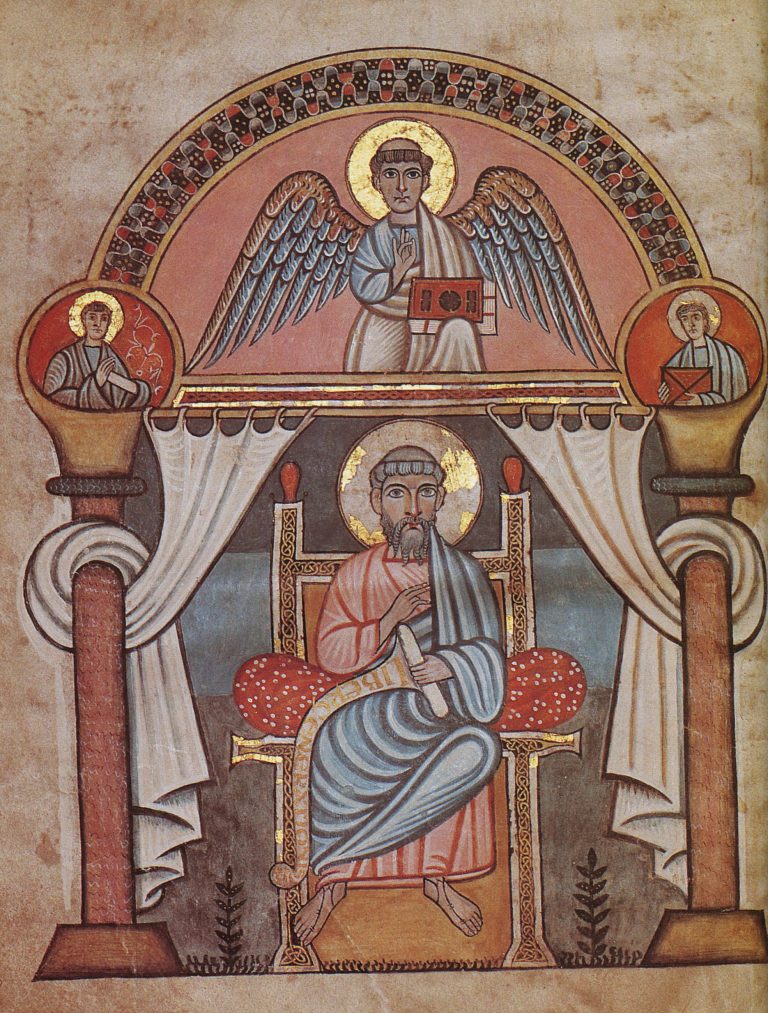
São Matheus escrevendo o Evangelho – Codex Aureus – 750
Data: meados do século VIII
Origem: Cantuária (?)
Extensão: 193 fólios
Idioma: Latim
São Matheus escrevendo o Evangelho – Codex Aureus – 750
Conheça o Codex Aureus:
Formato 395 x 314 mm (originalmente quatro), 6 tabelas canônicas, 7 iniciais do Proprietário, marca de prateleira Estocolmo, Kunigliga
A biblioteca, não sabe quem encomendou o manuscrito. O códice, originalmente da Igreja de Cristo em Oxford, foi saqueado pelos dinamarqueses, mas depois comprado pelo Conde (mais tarde Rei) Alfred e sua esposa no século IX e devolvido à Igreja de Cristo. Foi então perdido novamente, apenas para ser descoberto na Espanha por um antiquário sueco em 1690 e adquirido para Estocolmo.
Dos dois retratos de evangelistas sobreviventes, aquele que representa Mateus é particularmente impressionante. O evangelista, em traje clássico, é mostrado solenemente entronizado sob uma arcada de pilares, com rendas decorando sua sede real.
Embora tanto a figura como os restantes elementos pictóricos sejam estilizados e pareçam bidimensionais, a miniatura possui uma qualidade essencialmente monumental, graças à sua estrita simetria e à forma como foca os motivos principais.
O evangelista tem a mão direita elevada à altura do peito em bênção; abaixo dela, sua mão esquerda segura um pergaminho, enquanto seu símbolo, o anjo, está no tímpano da arcada, apresentando um códice.
Preso a um trilho abaixo da luneta está um par de cortinas que foram abertas e enroladas em torno dos pilares. Mas estes não devem ser considerados meramente decorativos. Pelo contrário, são uma referência à revelação, ao fato de o evangelista revelar os mistérios da fé.
As primeiras palavras do Evangelho de São Mateus, que o evangelista apresenta no seu pergaminho aberto, são “Liber Generationis”, ou seja, começa com a descrição da linhagem de Cristo.
Na página seguinte, bem perto do início do evangelho de São Mateus e depois de os antepassados do salvador terem sido listados, o nascimento de Cristo é descrito (“Christi autem generatio”).
Isto oferece espaço para um dos destaques da ornamentação da escrita, a ligadura do monograma de Cristo, ou seja, a ligação das letras gregas X e P para formar uma única e magnífica inicial. As letras minúsculas que se seguem testemunham o uso pródigo do ouro neste manuscrito.
Saint Matheus writing the Gospel – Codex Aureus – 750
Date: middle of the 8th century
Origin: Canterbury (?)
Extent: 193 folios
Language: Latin
Format: 395 x 314 mm (originally four), 6 canon tables, 7 initials Owner, shelf mark Stockholm, Kunigliga
Provenance It is not known who commissioned the manuscript. The codex, originally from Christ Church in Oxford, was looted by the Danes, but then purchased by Earl (later King) Alfred and his wife in the 9th century and returned to Christ Church. It was then lost again, only to be discovered in Spain by a Swedish antiquary in 1690 and acquired for Stockholm.
Of the two surviving evangelist portraits, the one representing Matthew is particularly impressive. The evangelist, in classical garb, is shown solemnly enthroned beneath a pillared arcade, with lacework decorating his royal seat.
Although both the figure and the other pictorial elements are stylised and look two-dimensional, the miniature possesses an essentially monumental quality, thanks to its strict symmetry and the way it focuses on the main motifs.
The evangelist has his right hand raised to chest height in blessing; beneath it, his left hand holds a scroll, while his symbol, the angel, is in the tympanum of the arcade, presenting a codex.
Fastened to a rail beneath the lunette is a pair of curtains which have been drawn aside and wound around the pillars. But these should not be thought of as merely decorative. On the contrary, they are a reference to revelation, to the fact that the evangelist is disclosing the mysteries of faith.
The first words of St. Matthew’s gospel, which the evangelist is presenting on his open scroll, are “Liber generationis”, in other words, it begins with the description of Christ’s lineage.
On the following page, very near the beginning of St. Matthew’s gospel and after the saviour’s fore- fathers have been listed, the birth of Christ is described (“Christi autem generatio”).
This offers scope for one of the highlights of script ornamentation, the ligature of the Christ monogram, in other words, the linking of the Greek letters X and P (chirho) to form a single, magnificent initial.
The small letters that follow bear witness to the lavish use of gold in this manuscript. Folio 9 verso / 10 recto.
Source: Codices Illustres, Ingo E. Walrher and Norbert Wofg, edit. Taschen.
Consulte a Agenda do Museu a partir de 2025 e o visite quando receber sua confirmação de visita em seu email ou whatsapp.
Por se tratar de um museu particular, é necessário se cadastrar na Comunidade MuMi e customizar sua visita.
Criação e Tecnologia: Clayton Tenório @2025 MuMi – Museu Mítico